Tilt Cabs am: of Engines at Frankfurt
Page 60
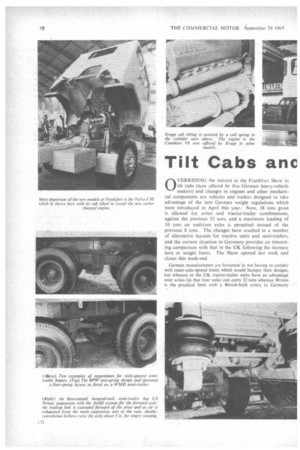
Page 61
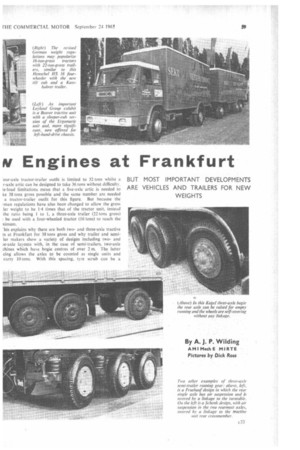
Page 62
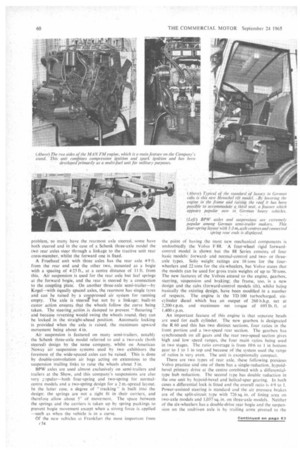
Page 65
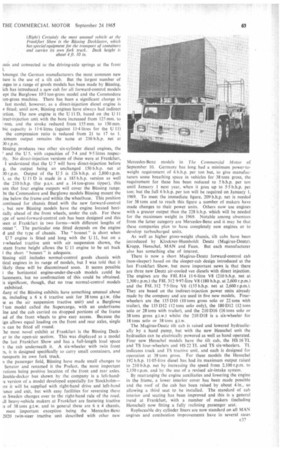
Page 66
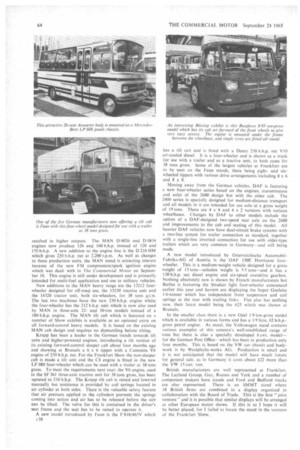
If you've noticed an error in this article please click here to report it so we can fix it.
OVERRIDING the interest at the Frankfurt Show in tilt cabs (now offered by five German heavy-vehicle makers) and changes in engines and other mechanical components are vehicles and trailers designed to take advantage of the new German weight regulations which were introduced in April this year. Now, 38 tons gross is allowed for artics and tractor-trailer combinations, against the previous 32 tons, and a maximum loading of 10 tons on undriven axles is permitted instead of the previous 8 tons. The changes have resulted in a number of alternative layouts for tractive units and semi-trailers, and the current situation in Germany provides an interesting comparison with that in the UK following the increase here in weight limits. The Show opened last week and closes this week-end.
German manufacturers are fortunate in not having to comply with outer-axle-spread limits which would hamper their designs, but whereas in the UK tractor-trailer units have an advantage over artics (in that four axles can carry 32 tons whereas 30 tons is the practical limit with a British-built artie), in Germany
our-axle tractor-trailer outfit is limited to 32 tons whilst a r-axle artic can be designed to take 36 tons without difficulty. le-load limitations mean that a five-axle artic is needed to ke 38 tons gross possible and the same number are needed a tractor-trailer outfit for this figure. But because the iman regulations have also been changed to allow the gross let weight to be 1-4 times that of the tractor unit, instead the ratio being 1 to 1, a three-axle trailer (22 tons gross) I be used with a four-wheeled tractor (16 tons) to reach the ximum.
"his explains why there are both twoand three-axle tractive Is at Frankfurt for 38 tons gross and why trailer and semiler makers show a variety of designs including twoand :e-axle layouts with, in the case of semi-trailers, two-axle chines which have bogie centres of over 2 m. The latter cing allows the axles to be counted as single units and carry 10 tons. With this spacing, tyre scrub can be a
problem, so many have the rearmost axle steered, some have both steered and in the.case of a Schenk three-axle model the two rear axles steer through a linkage to the tractive unit rear cross-member, whilst the forward one is fixed.
A Fruehauf unit with three axles has the rear axle 4-9 ft. from the rear end and the other two, mounted as a bogie with a spacing of 4-25 ft., at a centre distance of 11 ft, from this. Air suspension is used for the rear axle but leaf springs at the forward bogie, and the rear is steered by a connection to the coupling plate. On another three-axle semi-trailer—by Kogelk—with equally spaced axles, the rearmost has single tyres and can be raised by a compressed air system for running empty. The axle is steerer but not by a linkage; built-in castor action ensures that the wheels follow the curve being taken. The steering_actibn.is damped to prevent " fluttering" and because reversing would swing the wheels round, they can be locked in the straight-ahead position. Automatic locking is provided when the axle is raised, the maximum upward movement being about 4 in.
Air suspension is featured on many semi-trailers, notably the Schenk three-axle model referred to and a two-axle (both steered) design by the same company. whilst on American Neway air suspension systems used by two exhibitors the foremost of the wide-spaced axles can be raised. This is done by double-convolution air bags acting on extensions to the suspension trailing links to raise the wheels about 5 in.
IIPW axles are used almost exclusively on semi-trailers and trailers at the Show, and this company's suspensions are also very ;_--,-)pular—both four-spring and two-spring for normalcentre models and a two-spring design for a 2 m.-spread layout.
In the latter case, a degree of tracking is built into the design: the springs are not a tight fit in their carriers, and therefore allow about 5° of movement. The space between the springs and the carriers is taken up by spring packings to prevent bogie movement except when a strong force is applied --such as when the vehicle is in a curve.
Of the new vehicles at Frankfurt the most important from (34
the point of having the most new mechanical components is undoubtedly the Volvo F 88. A four-Wheel rigid forwardcontrol model is shown but the 88 Series consists of four basic models: forwardand normal-control and twoor threeaxle types. Solo weight ratings are 16 tons for the fourwheelers and 22 tons for the six-wheelers, but Volvo states that the models can be used for gross train weights of up to 70 tons. The new features of the .Volvos extend to the engine, gearbox. steering, suspension and braking; the frame, too, is a new design and the cabs (forward-control models tilt), whilst being basically the existing design, have been modified in a number of respects. The engine is the TD 100 turbocharged, sixcylinder diesel which has an output of 260 b.h.p. net at 2,200 r.p.m. and ,maximum net torque of 695 lb. ft. at 1.400 r.p.m.
An important feature of this engine is that separate heads are used for each cylinder. The new gearbox is designated the R 60 and this has two distinct sections, four ratios in the front portion and a two-speed rear section. The gearbox has synchromesh on all gears and the rear two-speed section gives high and low • speed ranges, the four main ratios being used in two stages. The ratio coverage is from 10.6 to I in bottom gear to 1 to I in top and because of the system used the range of ratios is very even. The unit is exceptionally compact.
There are two types of rear axle, these following previous Volvo practice and one of them has a single-reduction. hypoidbevel primary drive at the centre combined with a differentialtype hub reduction. The second type has double reduction in the one unit by hyPoid-bevel and helical-spur gearing, In both cases a differential lock is fitted and the overall ratio is 4-9 to I. Power-assisted steering is standard and the air pressure brakes are of the split-circuit, type with 726 sq. in. of lining area on two-axle models and 1,037 sq. in. on three-axle models. Neither of the six-wheelers has a double-drive rear bogie and the suspension on the undriven axle is by trailing arms pivoted to the issis and connected to the driving-axle springs at the front ikmongst the German manufacturers the most common new ture is the use of a tilt cab. But the largest number of inges to a range of goods models has been made by Bilssing. ich has introduced a new cab for all forward-control models ept the Burglowe 105 ton-gross model and the Commodore ion-gross machine. There has been a significant change in last model, however, as a direct-injection diesel engine is v fitted; until now, Bussing engines have always had indirect !ction. The new engine is the U 11 D. based on the U 11 irect-injection unit with the bore increased from 125 mm. to mm. and the stroke reduced from 155 mm. to 150 mm. hie capacity is 11.6 litres (against 11.4 litres for the U 11) the compression ratio is reduced from 21 to 17 to 1. .ximum output remains the same at 210 b.h.p. net at 30 r.p.m.
kissing produces two other six-cylinder diesel engines, the ' and the U 5, with capacities of 7-4 and 9.5 litres respecAy. No direct-injection versions of these were at Frankfurt, I understand that the U 7 will have direct-injection before g, the output being an unchanged 150 b.h.p. net at r.p.m. Output of the U 5 is 126 b.h.p. at 2,800 r.p.m. 1, as the U 11 D is made in a 185 b.h.p. version as well the 210 b:h.p. •(for p,s,v. and a 14 ton-gross titmer), this ans that four engine outputs will cover the Bilssing range. hi the Commodore and Burglowe models Bussing mount the ,inc below the frame and within the wheelbase. This position continued for chassis fitted with the new forward-control
but new Bussing models have the engine located hori[tally ahead of the front wheels, under the cab. For these epe of semi-forward-control cab has been designed and this teen at Frankfurt in two forms—with different lengths of onnet ". The particular one fitted depends on the engine d and the type of chassis. The " bonnet " is short when U 7 engine is fitted and long with the U 11, but on a r-wheeled tractive unit with air. suspension shown, the stant frame height allows the U 11 engine to be set back I the short " bonnet " is adequate.
kissing still includes normal-control goods chassis with tical engines in its range of models, but I was told that it Likely these will be discontinued soon. It seems possible t the horizontal engine-under-the-cab models could be lacements, but no confirmation of this could be obtained. is significant, though, that no true normal-control models exhibited.
4any of the Bussing exhibits have something unusual about including a 6 x 6 tractive unit for 38 tons g.t.w. (the le as the air suspension tractive unit) and a Burglowe 5ton model called the Supercargo, with an underframe inc and the cab carried on dropped portions of the frame ad of the front wheels to give easy access. Because the ign allows equal loading on the front and rear axles, single :s can be fitted all round.
'he most novel exhibit at Frankfurt is the Bussing Decker in the open-air section. This was displayed as a model the last Frankfurt Show and has a full-length load space a the cab underneath it. A six-wheeler with twin front n, it is designed specifically to carry small containers, and ransports its own fork truck.
the passenger field, Bussing have made small changes to Senator and renamed it the Prefect, the most important rations being positive location of the front and rear axles. double-decker bus shown by the company is a left-band:e version of a model developed especially for Stockholm— !re it will be supplied with right-hand drive and left-hand -ance and exit, but with easy facilities for reversing these :n Sweden changes over to the right-hand rule of the road. dl heavy-vehicle makers at Frankfurt are featuring tractive
of 38 tons g.t.w. and in general these are 6 x 4 chassis, most important exception being the Mercedes-Benz 2020 twin-steer tractive unit described with other new
Mercedes-Benz models in The Commercial Motor of September 10. Germany has long had a minimum power-toweight requirement of 6 b.h.p. per ton but, to give manufacturers some breathing space in vehicles for 38 tons gross, the requirement for these has been reduced to 5 b.h.p. per ton until January 1 next year, when it goes up to 5.5 b.h.p. per ton; but the full 6 b.h.p, per ton will be required on January 1. 1969. To meet the immediate figure, 209 b.h.p. net is needed for 38 tons and to reach this figure a number of makers have made changes to their power units. Others now use engines with a greater output than the 228 b.h.p. which will be needed for the maximum weight in 1969. Notable among absentees from the latter category are Mercedes-Benz and it may be that these companies plan to have completely new engines or to develop turbocharged units.
As well as higher gross-weight chassis, tilt cabs have been introduced by Klockner-Humboldt Deutz (Magirus-Deutz). Krupp, Henschel. MAN and Faun. But each manufacturer also has something else of interest.
There is now a short Magirus-Deutz forward-control cab (non-sleeper) based on the sleeper-cab design introduced at the last Frankfurt Show, but more important news is that there are three new Deutz air-cooled vee diesels with direct injection. The engines are the F8L 814 11.6-litre V8 (210 b.h.p, net at 2300 r.p.m.) the F8L 312 9:97-litre V8 (180 b.h.p. at 2,600 r.p.m.) and the F6L 312 7-5-litre V.6 (135 b.h.p. net at 2,600 r.p.m.). They are based on the indirect-injection power units already made by the company and are used in five new models. Fourwheelers are the 135 DIO (10 tons gross solo or 22 tons with trailer), the 135 D12 (12 tons solo only), the 180 D12 (12 tons solo or 28 tons with trailer), and the 210 D16 (I6 tons solo or 38 tons gross g.t.w.) whilst the 210 D18 is a six-wheeler for 18 tons solo or 38 tons g.t.w.
The Magirus-Deutz tilt cab is raised and lowered hydraulically by a hand pump, but with the new Henschel unit the hydraulics can be electrically powered as well as hand operated. Four new Henschel models have the tilt cab, the HS 16 TL and TS four-wheelers and HS 22 IL and TS six-wheelers, TL indicates truck and TS tractive unit, and each is designed for operation at 38 tons gross, For these models the Henschel 192 b,h.p. 11.05-litre diesel has had its maximum output raised to 210 b.h.p. net by increasing the speed from 2,100 r.p.m. to 2,150 r.p.m. and by the use of a revised air-intake system.
By rearranging the engine auxiliaries and lowering the engine in the frame, a lower interior cover has been made possible and the roof of the cab has been raised by about 4 in., so allowing a third seat to be installed. The standard of cab interior and seating has been improved and this is a general trend at Frankfurt, with a number of makers (including Henschel) now fitting a fully reclining passenger seat.
Replaceable dry cylinder liners are now standard on all MAN engines and combustion improvements have in several cases c3 7
resulted in higher outputs. The MAN D 0026 and D 0836 engines now produce 126 and 160 b.h.p. instead of 120 and 150 b.h.p. A new addition to the engine line is the D 216 HM which gives 230 b.h.p. net at 2.200 r.p.m. As well as changes to these production units. the MAN stand is attracting interest because of the new FM compression/spark ignition engine which was dealt with in The Commercial Motor on September 10. This engine is still under development and is primarily intended for multi-fuel application and use in military vehicles.
New additions to the MAN heavy range are the 13212 fourwheeler designed for off-road use, the 13230 tractive unit and the 14320 tractor unit, both six-wheelers, for 38 tons g.t.w. The last two machines have the new 230 b.h.p. engine whilst the four-wheeler has the 212 b.h.p. unit which is now also used by MAN in three-axle 22and 30-ton models instead of a 180 b.h.p. engine. The MAN tilt cab which is featured on a number of Show exhibits is available as an optional extra on all forward-control heavy models. It is based on the existing MAN cab design and requires no dismantling before tilting.
Krupp has been a leader in the German trends towards tilt cabs and higher-powered engines, introducing a tilt version of its existing forward-control sleeper cab about four months ago and showing at Brussels a 6 x 6 tipper with a Cummins V8 engine of 250 b.h.p. net. For the Frankfurt Show the non-sleeper cab is made a tilt unit and the C8 engine is fitted in the new LF 980 four-wheeler which can be used with a trailer at 38 tons gross. To meet the requirements next year. the V6 engine, used in the SF 361 three-axle tractive unit for 38 tons gross, has been uprated to 210 b.h.p. The Krupp tilt cab is raised and lowered manually but assistance is provided by coil springs located in air cylinder at both sides. There is the valuable safety feature that air pressure applied to the cylinders prevents the springs corning into action and air has to be released before the cab can be tilted. The valve for this is contained in the driver's seat frame and the seat has to be raised to operate it.
A new model introduced by Faun is the F 610/465V which c38 has a tilt cab and is fitted with a Deutz 250 b.h.p. net VII) air-cooled diesel. It is a four-wheeler and is shown as a truck for use with a trailer and as a tractive unit, in both cases for 38 tons gross. Some of the largest vehicles at Frankfurt are to be seen on the Faun stands, there being eightand sixwheeled tippers with various drive arrangements including 8 x 6 and 8 x 8.
Moving away from the German vehicles. DAF is featuring a new four-wheeler series based on the engines, transmissions and axles of the 2600 design but with the older cab. The 2400 series is specially designed for medium-distance transport and all models in it are intended for use solo at a gross weight of 19 tons. There are 4 x 4 and 4 x 2 versions with various wheelbases. Changes by DAF to other models include the option of a DAF-designed two-speed rear axle on the 2600 and improvements to the cab and seating of this model. .All heavier DAF vehicles now have dual-circuit brake systems with a two-line system for trailer connection as standard, together with a single-line inverted connection for use with older-type trailers which are very common in Germany—and still being made.
A new model introduced by Osterreichische AutomobilFabriks-AG of Austria is the OAF 130E Hurricane fourwheeler. This is a medium-weight vehicle designed for a gross weight of 13 tons—unladen weight is 5-5 tons—and it has a 130 b.h.p. net diesel engine and six-speed overdrive gearbox. Nothing absolutely new is shown by French manufacturers but Berliet is featuring the Stradair light four-wheeler announced earlier this year and Saviem are displaying the Super Goelette l-6-tonner which has independent front suspension and coil springs at the rear with trailing links. Fiat also has nothing new, their latest model being the 625 which was shown at Brussels.
In the smaller class there is a new Opel 1-9 ton-gross model which is available in various forms and has a F9 litre. 82 b.h.p.gross petrol engine. As usual, the Volkswagen stand contains various examples of this concern's well-established range of vans but there is also a specially developed 8 cwt. model—. for the German Post Office—which has been in production only four months. This is based on the VW car chassis and bodywork is by Westphalia-wcrke AG. Production is small and it is not anticipated that the model will have much future for general sale, as in Germany it costs about f22 more than the VW 15 cwt. van.
British manufacturers arc well represented at Frankfurt. The Leyland Group, Guy, Rootes and York and a number of component makers have stands and Ford and Bedford trucks are also represented. There is an SMMT stand where 18 British firms are combined in a display organized in -collaboration with the Board of Trade. This is the first "joint venture" and it is possible that similar displays will be arranged at other European motor shows. If this is so I hope it will be better placed, for I failed to locate the stand inthe vastness of the Frankfurt Show.
























































































































